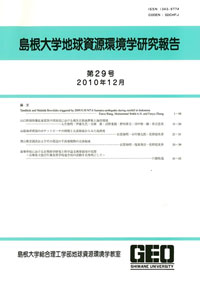島根大学総合理工学部地球資源環境学教室
ISSN:1343-9774

ダウンロード数 : ? 件
この文献の参照には次のURLをご利用ください : https://ir.lib.shimane-u.ac.jp/6149
島根大学地球資源環境学研究報告 24
2005-12-27 発行
島根県東部,古第三紀後期梅木花崗岩の岩石学的研究 : 山陰中央部の因美期および田万川期貫入岩類の岩石化学的比較
A petrological study of the Iate Paleogene Umeki granite in the central San'in district,SW Japan : petrochemical correlation between the late Cretaceous-Paleocene lnbi and Eocene-Oligocene Tamagawa lntrusives in the central San'in district
飯泉 滋
高橋 亮
ファイル
内容記述(抄録等)
Cretaceous-Paleogene intrusive rocks in the central San'in district are geochronologically divided into the late Cretaceous-Eocene Inbi and Eocene-Oligocene Tamagawa Intrusives.The Umeki granite,one of the Tamagawa Intrusives,is a stock composed mainly of granite porphyry,granophyre and aplitic granite with small amounts of mediumgrained equigranular biotite granite.Nine whole rock samples give a well-defined isochron age of 31.2±1.7 Ma with an initial Sr isotope ratio of 0.70437± 0.00017,indicating that the granite is one of the youngest Tamagawa Intrusives in the central San'in district.Petrochemically the Umeki granite is characterized by lower Rb,Zr and Nb contents and Rb/K_2O ratio,and also by distinctly lower initial Sr(Srl)and higher Nd isotope ratios(NdI) (0.51273-0.51277)than the Inbi Intrusives in the central San'in district.Comparing with the most Inbi Intrusives,the Tamagawa Intnlsives have in general lower K_2O and Rb contents and lower Rb/K_2O ratio,and also lower SrI(0.70416-0.70507)and higher Ndl(0.51263-0.51277).If the Inbi and Tamagawa Intrusives were derived from the lower crust beneath the San'in district by partial melting,the isotope ratios of the magma source must have been changed after the Inbi magmatism,because Srl and NdI of the Inbi Intrusiives are in the ranges 0.70477 to 0.70681 and 0.51244 to 0.51258,respectively.The changes in the isotope ratios of the lower crust may be explained by injection of mafic magmas after the Paleocene which had higher Sr and Nd contents and lower Sr(around 0.703)and higher Nd isotope ratios(around 0.513)than the lower crustal materials before 50 Ma.Tentative mixing calculations indicate that 20-30 % mixing of such magmas with the lower crust possibly change the isotope ratios of the lower crust to the appropriate values.Contamination of the Inbi magmas with the upper crustal materials would not have played an important role for having caused the isotopic differences between the Inbi and Tamagawa Intrusives.
Other Article
